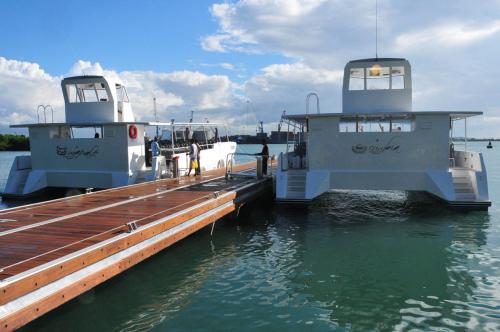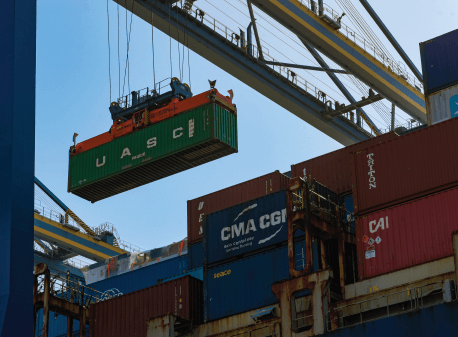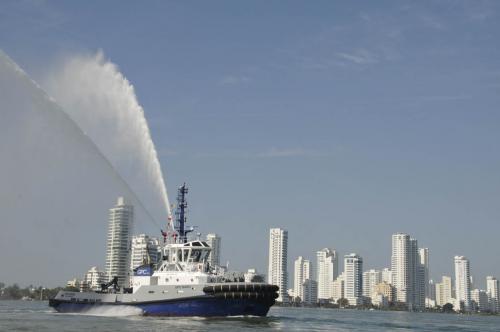In this section, only use the image in the description at the beginning, the rest is text.
In order to provide comprehensive assistance that adds value to cargo and increases the competitiveness of Colombian importers and exporters, the Port of Cartagena Group offers various complementary services through its affiliated companies:
Compañía Estibadora Colombiana SAS, CEC SAS
It provides support in maritime and land port operations. It connects the Port of Cartagena Group’s terminals with the intra-terminal transfer of cargo and has specialized ground equipment to facilitate operations, such as the rental of Reach Stackers. This equipment, which is used to handle containers in port terminals, plays a significant role in time management—it transports containers quickly over short distances and can stack them. It is also able to move “oversized” cargo.
CEC also rents two versatile and safe catamarans to support tourism operations and events. Each of these vessels can carry up to 100 passengers, in accordance with strict safety and comfort conditions to meet the demanding standards of maritime transportation.


Sociedad Portuaria Operadora Internacional S.A.
The corporate purpose of this company is to invest in the construction and maintenance of ports and their administration, the provision of loading and unloading services, warehousing, and other services directly related to its port activity:
● High-precision bathymetric surveys.
● Deepening and maintenance of access channels, docks, and inlets.
● Dredging of berthing and quay line sectors of sea and river ports.
● Dredged soil to form future port expansion areas, industrial zones, and recreational beaches.
● Construction of storage areas for dredged material, including overflows and drainage channels.
● Final disposal of contaminated sediments.
In order to provide services tailored to its customers’ specific needs, it has a wide range of equipment, such as bathymetries, a tugboat, and a cutter and suction dredge. This guarantees the highest quality standards, ensuring optimal environmental management in each process.
GPC TUGS S.A.S: remolcadores de vanguardia
This company offers state-of-the-art maritime tugboat services that are capable of handling cruise ships and vessels of up to 16,000 TEUs or 180,000 tons, and to support the maneuvers of any type of vessel arriving in the Bay of Cartagena.
Among its comparative advantages are its high maneuverability for port and salvage operations, as well as its technological development, design, propulsion system, safety, and environmental characteristics.
GPC TUGS operates 24 hours a day under certified international standards. It provides services such as docking and undocking maneuvers, specialized terminal operations, towing, fire and pollution control services, and salvage.


Terminal Fluvial Andalucía S.A.
In addition to the Port of Cartagena Group’s maritime terminals and its affiliated companies, there is a new project focused on boosting the competitiveness of both the port and Colombia—the Andalucía River Terminal. This is currently under construction in the municipality of Gamarra, César, on the banks of the Magdalena River, with the objective of increasing Colombia's internal connectivity.
Gamarra is par excellence the center of connections for the national logistics network. It is equidistant between the Colombian Caribbean ports and the country's main production centers. It is located six hours from Venezuela, and is situated in a place where the Magdalena River, the railroad, and the Ruta del Sol—one of the country's main roads—converge.
With the same international standards of functionality and productivity of the Sociedad Portuaria Regional de Cartagena and Contecar, the river terminal will move vehicles, containers, solid and liquid bulk cargo, fuels, and breakbulk cargo in general.
The benefits
● It will connect to 80% of Colombia's population through the Magdalena River.
● It will allow the intermodal connection of the Port of Cartagena with the main production centers: Bogotá, Medellín, Manizales, Pereira, Bucaramanga, Cúcuta, and San Cristóbal in Venezuela.
● It will reduce the cost of freight for domestic cargo by 30%.
● It will enable optimal management of cargo inventories.
● It will reduce CO2 emissions.
● It will provide 335 hectares for logistics innovation, connectivity, and increased national competitiveness.

